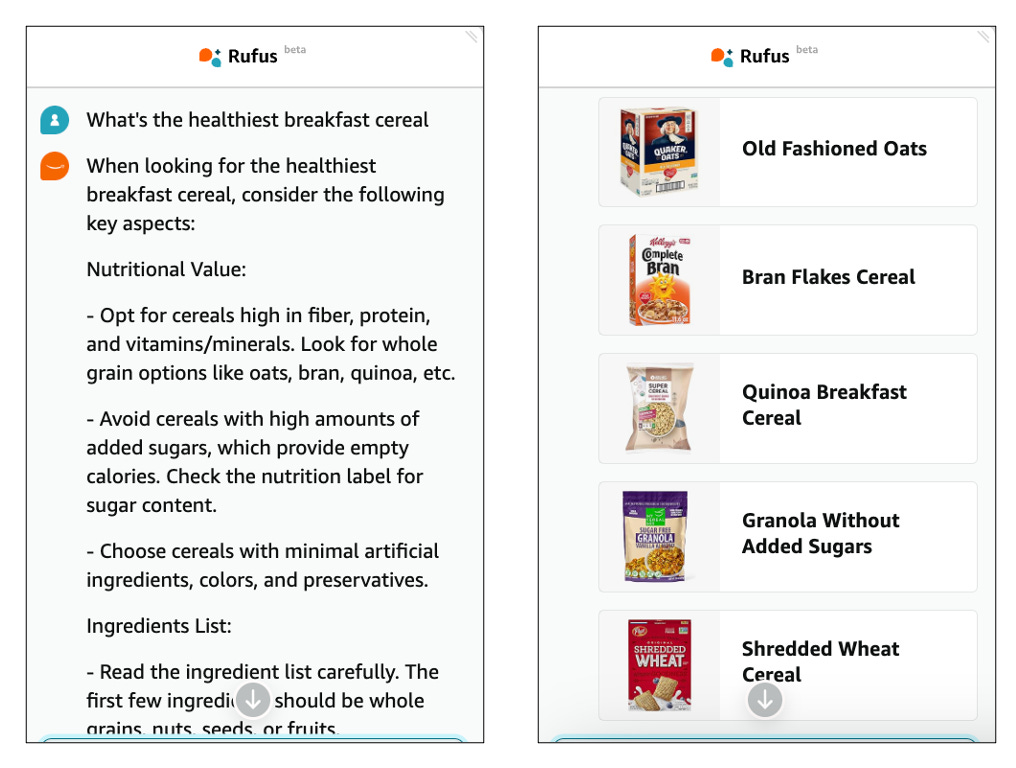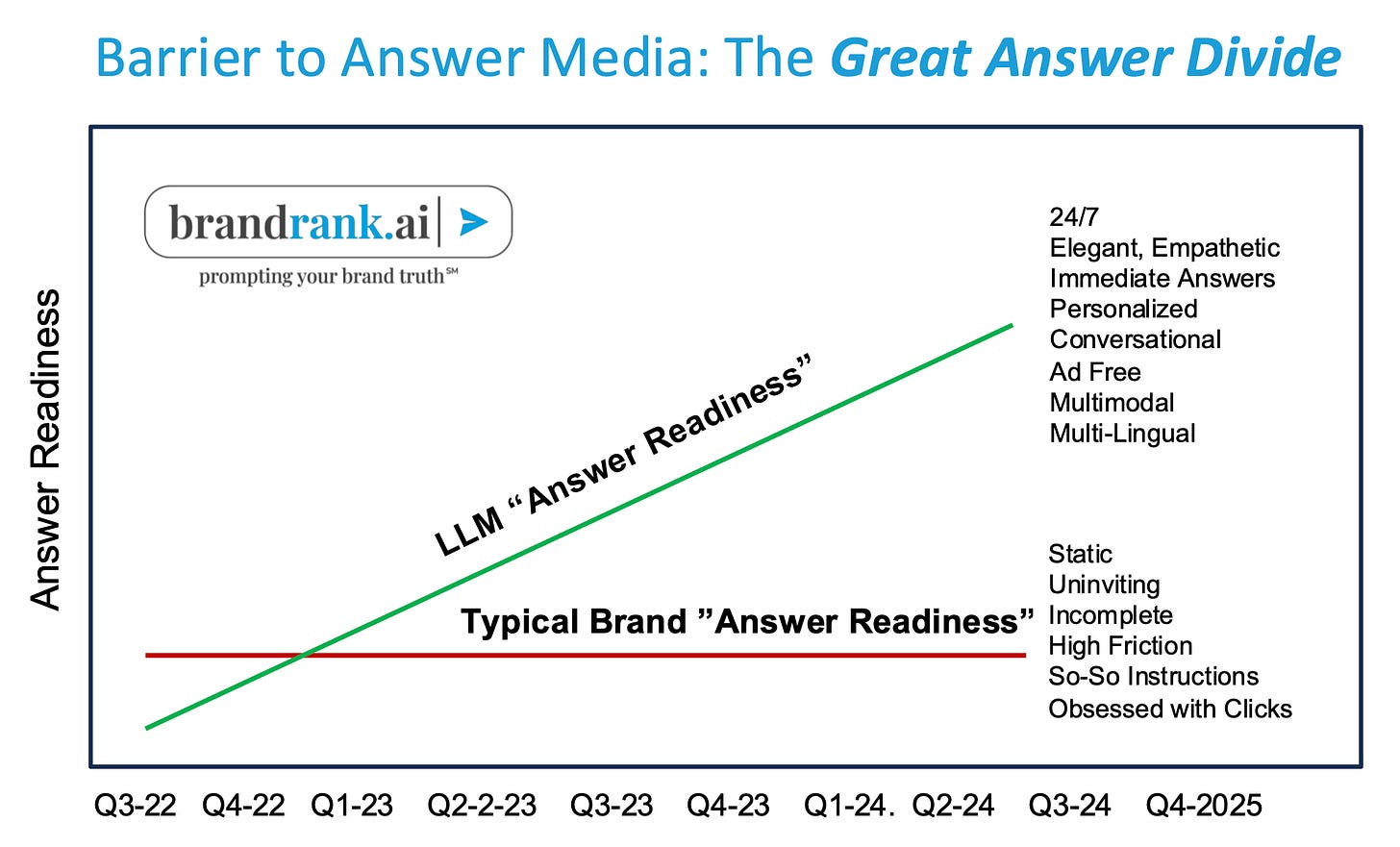SEO Is Declining Fast. The Future Belongs to "Answer Media"
Introducing "Answer Media" -- The New Currency of Competitive Advantage
Nearly two decades ago, amidst building one of the first social listening companies, I coined the term "Consumer Generated Media" (CGM) to highlight how consumer conversations functioned as media. I resisted the term "user-generated content" because I felt it didn't do justice, especially in the eyes of media owners and CFOs, to the impact of online conversations and word-of-mouth.
Today, we are at another inflection point—the "Answer Economy," where the most valuable impression isn’t an ad or a post, but what answer engines say about your brand, category, product, and experience.
We are entering the era of Answer Media.
Answers as De Facto Media
AI-driven Answer Engines like ChatGPT, Google Gemini, and Amazon Rufus function as de facto media because they inform, influence, and shape public perception—they are the new marketing and shopper funnel. Just as traditional media filtered and framed information for audiences, Answer Engines now determine which facts, sources, and perspectives surface in response to queries.
Their responses are shaped by AI training data, bias mitigation efforts, and evolving algorithms, making them akin to a constantly evolving editorial framework. This is a huge deal when research suggests the top driver of generative AI is researching products and services (BrandRank, CapGemini).
Users increasingly consume AI-generated answers without clicking external links, centralizing media consumption within AI-driven platforms. This “zero click” environment forces brands, news outlets, and content creators to optimize their content for visibility within these AI-generated responses rather than relying on traditional digital strategies. This is akin to a 8.0 California Earthquake.
The Disruption of Traffic and the Evolution of AI Search
As AI-generated answers become the primary way users receive information, traditional referral traffic from search engines is declining. Gartner estimates a decline of 50% by 2028, an estimate many AI pundits deem conservative. If AI-generated answers replace traditional search traffic, brands that fail to integrate into Answer Media will be left behind.
Unlike search engines that serve multiple links, Answer Engines curate a single synthesized response—what we call a "Prompted Moment of Truth"—effectively acting as gatekeepers of information. Answers are “blended like a smoothie.”
This shift represents Phase Two of AI Search, where search engines move from supplementing search results with AI-generated summaries to replacing them as the primary method of delivering information. Google’s AI Model, which Casey Newton wrote about this week, is a clear example of this evolution, as it queries multiple topics simultaneously, synthesizes answers, and deprioritizes links.
This is why Answer Media is now the new front page of the internet. Brands must rethink their visibility strategies and optimize for AI-driven responses rather than relying on conventional SEO.
Answer Engines at the Moment of Purchase
Amazon Rufus, powered by Anthropic’s Generative AI, demonstrates how Answer Media now sits at the moment of purchase, disrupting traditional shopping behaviors. Consumers are turning to AI-driven answers to guide purchasing decisions, making authoritative, objective responses more critical than ever.
Answer Media is also allowing consumers to easily enter the funnel at the category and “needs” stage — e.g. “what’s the healthiest food for my child,” and “Answer Media” like Amazon Rufus enthusiastically oblige. In fact, that’s how they build trust.

This shift forces brands to rethink visibility. No longer can they rely solely on paid placements or traditional SEO rankings. AI prioritizes credibility, transparency, and product superiority, meaning brands must align their messaging with what answer engines deem authoritative and relevant.
Answer Media’s power lies in its fierce objectivity—its credibility must hold up under consumer scrutiny. This is a big reason why there’s so much caution among answer engines about wrapping advertisements around their model.
The Answer Divide: A New Challenge for Brands
Brands today must understand how to optimize their own "Answer Media," and most are either failing or don't yet understand what's happening. For instance, most brands struggle to answer even the most basic questions on their owned media assets like websites, leaving gaps—what we call the Answer Divide—where misinformation or competitor content fills the void.
Closing this gap requires brands to take control of their presence in AI-generated answers. This means:
Optimizing Content – Ensuring websites, product descriptions, FAQs, and third-party content align with how AI engines synthesize and present information.
Building Credibility Signals – Leveraging BBB ratings, independent reviews, expert endorsements, and certifications to reinforce trustworthiness.
Understanding AI Visibility Factors – Learning how structured data, linked sources, and algorithmic anchors influence answer engine decisions.
The Future: Managing & Measuring Answer Media
Brands must rethink their media mix. Just as media planners allocate budgets across social, display, and search, they now need to integrate Answer Media strategies. This requires developing AI-friendly content that aligns with answer engines, proactively responding to consumer questions with credible and detailed answers, and tracking brand presence across AI-generated responses to measure impact.
They may also need to elevate in strategic importance functions like customer service or "consumer services," which historically have been on the front lines of addressing consumer questions and comments yet funded akin to a "neglected stepchild" (to borrow a phrase from my book). By prioritizing these efforts, brands can position themselves as authoritative sources in the evolving landscape of AI-driven search.
The New Playbook for Marketers
If social media taught brands engagement, Answer Media will teach them how to inform, clarify, and persuade through AI. Actively enroll new stakeholders like R&D into making companies more answer-ready as "Answer Engines" dig far beyond marketing slogans for everything from product performance data to carbon footprint levels. The most successful brands will:
Understand inputs shaping AI-generated responses.
Build a credible, data-driven brand story that AI recognizes and amplifies.
Continuously monitor and optimize their standing in the Answer Economy.
Answer Engines as "The New Front Page"
Answer Engines are the new front page of the internet—curating, contextualizing, and delivering information in ways that shape user perception and decisions. Their output, 'Answer Media,' is among the most coveted media currency for marketers. Brands, publishers, and policymakers must adapt as they did in past digital media revolutions.
The AI battleground is no longer just about paid visibility—it’s about ensuring your brand has a place in the answers shaping consumer decisions.
Are you ready for the Answer Media era?




great article